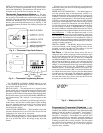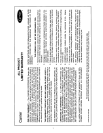OPERATION
The Mode button selects the operating mode of the ther-
mostat. If OFF is selected, the thermostat will not enter Heat-
ing or Cooling mode. If HEAT is selected, the thermostat
will only enter Heating mode (if the room temperature is
below the heating set point). If COOL is selected, the ther-
mostat will only enter Cooling mode (if the room tempera-
ture is above the cooling set point). If AUTO is selected, the
thermostat will enter Heating or Cooling mode based on the
room temperature and the heating and cooling set points. If
PROGRAM ON is selected, the stored schedule is enabled
and the thermostat will follow the Occupied and Unoccu-
pied schedules stored in its memory.
Auto-Changeover — When the thermostat mode is set
to AUTO, the thermostat will provide automatic changeover
from Heating to Cooling mode and Cooling to Heating mode
when required. The thermostat will automatically switch to
maintain the desired temperature setting. The thermostat does
not need to be manually changed from heating to cooling or
cooling to heating operation.
Two-Stage Operation — The second stage of heat or
cool is turned on when the first stage has been on for a mini-
mum of 2 minutes and the temperature differential from the
set point is equal to or greater than the set point plus the
deadband plus 2 degrees.
Clock Backup — In the event of a power loss, the ther-
mostat will keep time for a minimum of 48 hours without
external power or batteries.
Fan Operation — If Fan On is selected, the fan will run
continuously during occupied schedule (except when Mode
is switched to OFF). The fan will be off during unoccupied
schedule except during heating or cooling operation.
If Fan On is not selected, the fan will only operate during
heating or cooling operation.
Emergency Heat — Emergency heat is available for heat
pump applications. To turn on emergency heat, press and hold
the Fan button. While holding the Fan button, press the UP
button for 2 seconds. An ‘‘EH’’ will be displayed. During
emergency heat, the fan will operate and the second stage of
heat will be energized (locking out the first stage compres-
sor). To exit emergency heat, press and hold the Fan button.
While holding the Fan button, press the UP button for 2 sec-
onds. During emergency heat, only OFF and HEAT modes
are available.
Electric Heat — When the Electric Heat option in the
advanced set up is set to ON (configured by installer), the
thermostat will turn on the fan immediately any time there
is a heat demand. This feature should only be used on elec-
tric heating applications. Do not use with gas heat.
Holiday Mode — When the thermostat is in Holiday mode,
the thermostat will operate under Unoccupied set points. To
configure and activate the Holiday mode, press the Holiday
button. The ‘‘HOL’’ icon will be displayed along with the
remaining days of Holiday mode operation. Press the UP or
DOWNARROWS to select the number of days that the holi-
day schedule will be in effect. A value of 0 disables Holiday
mode. The duration can be set from 1 to 99 days. The ther-
mostat will enter Holiday mode on midnight of the next day
after the mode has been activated. Holiday mode will re-
main in effect until midnight of the last configured day.
If the Holiday mode is in effect, the number of days re-
maining will blink on and off and the ‘‘Unoccupied’’ icon
will be displayed. The Override button will be active during
Holiday mode. The Dry Contact Switch is ignored.
To turn off the Holiday mode before the remaining con-
figured days have passed, press the Holiday button to enter
into the configuration mode. Press the DOWN ARROW to
set the number of days to zero. Holiday mode will be
disabled.
Dry Contact Switch — A dry contact switch is pro-
vided to allow an external device to force the thermostat into
Occupied 1. When the thermostat is forced into Occupied 1
via the dry contact closure, the Occupied 1 icon will blink
each second.
SOFT START — When multiple thermostats are controlled
by the same external device, a Soft Start option can be used
to stagger the turn on times of the HVAC equipment. This
feature may cause a delay in operation after entering
Occupied 1.
Remote Temperature Sensor — A remote tempera-
ture sensor is available to read the temperature from a space.
If a remote temperature sensor is connected, the thermostat
will ignore the reading of its internal sensor. When the ther-
mostat is using a reading from a remote sensor, the degree
symbol above the temperature reading will blink.
4










